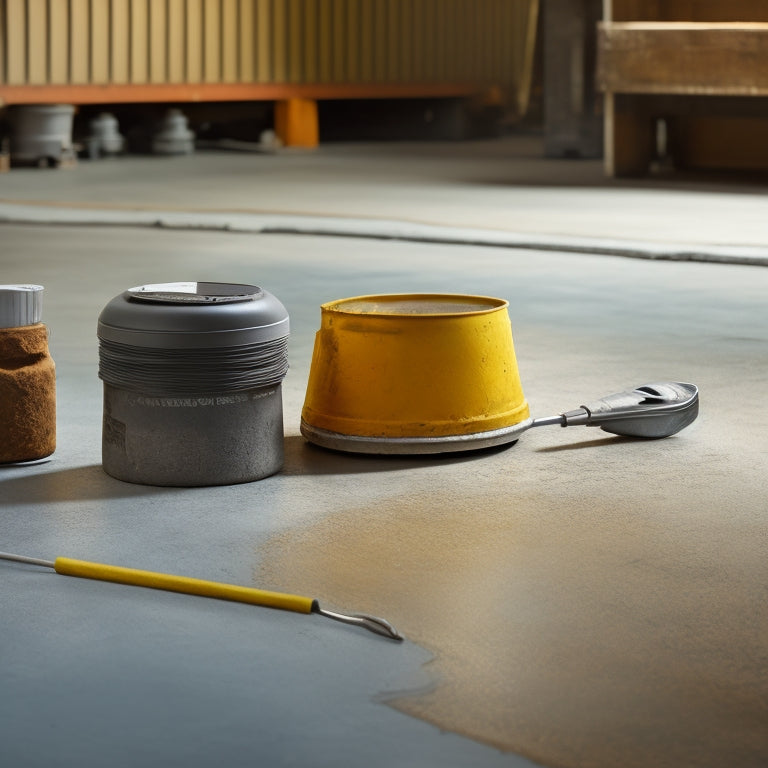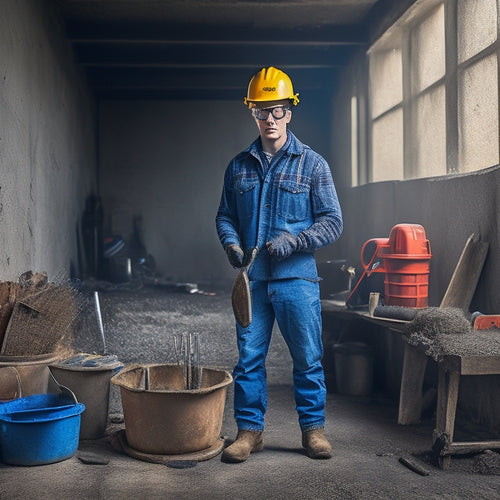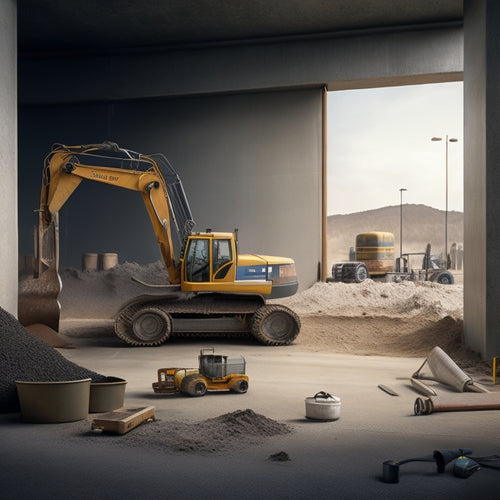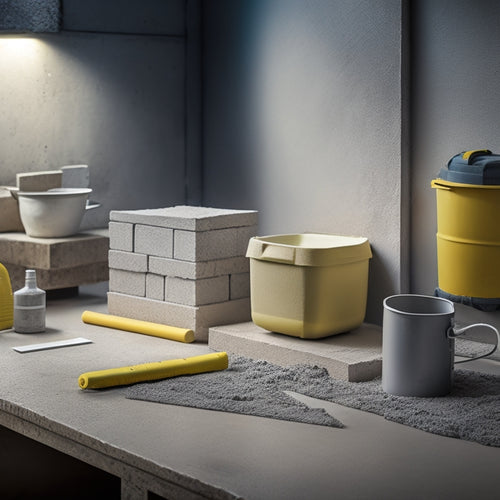
Why Polished Concrete Requires Specialized Restoration Tools
Share
You need specialized tools for polished concrete restoration because the process demands precision and power. Ordinary equipment can't handle aggressive material removal, precise surface preparation, and meticulous finishing required for a high-gloss finish. High-torque grinders, diamond pads, and high-pressure cleaning equipment are essential for efficient material removal and surface preparation. Specialized edging and corner tools guarantee precise profiling, while dustless vacuum systems assure a safe working environment. With the right tools, you'll be able to achieve the desired finish, and by exploring these requirements further, you'll uncover the secrets to a showroom-quality polished concrete floor.
Key Takeaways
• Specialized grinders are necessary for efficient material removal and creating a smooth surface for polishing.
• Diamond pads with progressive grit sequences are required for aggressive removal and refinement of the concrete surface.
• High-pressure cleaning equipment is essential for removing impurities and ensuring a clean surface for restoration.
• Edging and corner tools with adjustable handles and interchangeable blades provide precision and control for detailed work.
• Dustless vacuum systems are crucial for capturing dust and complying with safety regulations, reducing health risks and airborne particles.
Essential Grinders for Smooth Finish
When tackling a polished concrete restoration project, you'll need the right grinders to achieve a smooth finish, and that starts with choosing the most suitable equipment for the job.
The grinder you select will have a significant impact on the final result, making it vital to understand the different types and their applications. For concrete polishing, you'll want a grinder that can handle surface preparation, which involves removing old coatings, adhesives, and imperfections.
A planetary grinder or a walk-behind grinder with a high torque output is ideal for this stage. These grinders are designed to handle the heavy workload of surface preparation, allowing you to efficiently remove material and create a smooth surface.
By choosing the right grinder for the job, you'll be able to achieve a high-gloss finish that showcases the beauty of polished concrete.
Diamond Pads for Aggressive Removal
You'll rely on diamond pads with aggressive grits to effectively remove thick coatings, old adhesives, and stubborn imperfections from the concrete surface. These pads are designed to tackle the toughest removal tasks, and their diamond grit types are specifically engineered for maximum aggression.
When selecting a diamond pad, you'll want to evaluate the type of coating or adhesive you're removing, as well as the condition of the underlying concrete.
Here are some key factors to keep in mind when working with diamond pads for aggressive removal:
-
Coarser diamond grits (16-30) are ideal for removing thick epoxy coatings or old adhesives.
-
Medium-grit diamonds (40-60) are better suited for removing thin coatings or surface imperfections.
-
Higher-grit diamonds (80-120) are used for refining the surface and preparing it for polishing techniques.
-
Metal-bond diamonds are more aggressive than resin-bond diamonds and are used for heavy removal tasks.
-
Always work progressively through the grit sequence to avoid scratching the concrete surface.
High-Pressure Cleaning Equipment Needed
Following aggressive removal with diamond pads, high-pressure cleaning equipment is essential to remove any remaining residue, dirt, and debris from the concrete surface.
You'll need a pressure washer that can deliver a minimum of 3,500 PSI to effectively clean the surface. The pressure washer benefits include increased efficiency, as it can cover a larger area in less time, and better surface preparation, which is critical for the next stages of restoration.
When selecting a pressure washer, consider the type of nozzle and tips you'll need. A wide fan tip is ideal for covering large areas, while a narrow tip is better suited for tight spaces and corners. Additionally, make sure you have the appropriate hose length and diameter to guarantee consistent pressure and flow rate.
Proper surface preparation is key to achieving a successful restoration. High-pressure cleaning equipment helps remove any remaining impurities, guaranteeing a clean slate for the next steps in the process.
Specialized Edging and Corner Tools
To guarantee a precise and consistent finish, especially in areas where the pressure washer can't reach, specialized edging and corner tools are essential for removing residue and debris from edges, corners, and other tight spaces. These tools help you achieve professional-looking results and prevent imperfections that can compromise the entire restoration process.
When it comes to corner finishing techniques, you'll need tools that can navigate tight angles and curved surfaces. Here are some essential specialized edging and corner tools to have in your arsenal:
-
Electric edgers with adjustable handles for comfortable grip and control
-
Corner finishing tools with interchangeable blades for customized corner profiling
-
Edging tool maintenance kits for regular cleaning and sharpening
-
Dust-collecting edging tools for reduced mess and improved visibility
-
Precision corner tools with built-in LED lights for enhanced visibility in dark areas
Dustless Vacuum Systems for Safety
As you work to achieve precision and consistency in your polished concrete restoration, controlling dust and debris becomes a top priority to guarantee a safe and healthy work environment. You can't afford to compromise on safety, especially when it comes to dust containment. That's where dustless vacuum systems come in – an essential tool in your arsenal to verify compliance with safety regulations.
These systems are designed to capture dust and debris at the source, preventing them from becoming airborne and reducing the risk of respiratory issues or other health problems. By using a dustless vacuum system, you can notably reduce the amount of dust that's released into the air, creating a cleaner and safer workspace.
When selecting a dustless vacuum system, look for one that's specifically designed for concrete restoration applications. These systems typically feature high-performance filters, powerful motors, and durable construction to withstand the demands of your job site.
Frequently Asked Questions
Can Polished Concrete Be Restored With Regular Cleaning Products?
You're wondering if polished concrete can be restored with regular cleaning products.
The short answer is, it's not recommended. Regular cleaning products often compromise cleaning effectiveness and can even damage the polished surface.
You need products that are specifically designed for polished concrete to guarantee compatibility and avoid etching or discoloration.
Using the wrong products can lead to a dull, damaged finish that's difficult to repair.
How Long Does Polished Concrete Restoration Typically Take?
You'll be surprised to know that 80% of polished concrete floors show signs of deterioration within the first two years of installation.
When it comes to restoration, you're likely wondering how long the process takes. The duration of polished concrete restoration typically ranges from a few days to several weeks, depending on the extent of damage and required restoration techniques.
Thorough surface preparation is essential, and that's where specialized tools come in – ensuring a flawless finish and extended lifespan for your polished concrete floor.
Is Polished Concrete Restoration a Diy-Friendly Project?
You're wondering if polished concrete restoration is a DIY-friendly project? Honestly, it's not recommended.
Polished concrete techniques require specialized knowledge and skills to achieve a high-gloss finish. Additionally, you'll need access to heavy-duty restoration equipment, such as grinders and polishers, which can be expensive and difficult to operate.
Without proper training and equipment, you risk damaging the concrete or achieving subpar results, making it a project best left to professionals.
Can All Concrete Floors Be Polished and Restored?
You're probably thinking every concrete floor is a blank canvas waiting for a polishing makeover, but sadly, it's not that simple.
Not all concrete floors can be polished and restored to their former glory. The truth is, only floors with a solid, intact substrate can reap the polished concrete benefits.
That's where advanced restoration techniques come in, helping to identify and address underlying issues before applying a shine.
Does Polished Concrete Restoration Affect Flooring Warranties?
When you're considering polished concrete restoration, you'll want to know how it affects your flooring warranties.
The good news is that, in most cases, restoration won't void your warranty.
However, it's essential to choose restoration techniques that align with the manufacturer's guidelines to avoid any warranty implications.
You'll need to review your warranty terms and consult with a professional to guarantee the restoration process meets the necessary standards, so you can enjoy your beautifully restored floors while maintaining your warranty coverage.
Conclusion
As you wrap up your polished concrete restoration project, remember that the right tools are the keys to revealing a showroom shine.
Think of it like a master chef's kitchen - without the right knives, pots, and pans, even the simplest dish can turn into a culinary disaster.
According to the Concrete Polishing Association of America, a single misstep in tool selection can add up to 50% to the project timeline.
Don't let that happen - invest in the specialized tools outlined above to serve up a flawless finish.
Related Posts
-

What Tools Do I Need for Concrete Wall Repair
As you prepare for a concrete wall repair job, you'll need a variety of tools to guarantee a successful outcome. Star...
-

Why You Need Affordable Concrete Wall Construction Tools
You need affordable concrete wall construction tools to guarantee a profitable project, as the cost of equipment can ...
-

What Tools Do I Need for Concrete Block Laying
You'll need a thorough set of tools to guarantee accurate, efficient, and professional concrete block laying. Essenti...


